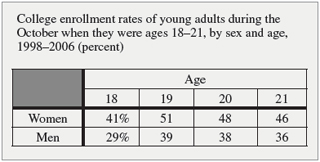
Summer 2009
Vol. 53, Number 2
|

















|
|
|
|

|
|
 Download the PDF
(224K)
Download the PDF
(224K)
Grab Bag
from past issues
|
|
Want to build a career? Consider construction.
ConstructMyFuture.com is a Web site with details about occupations, training, and other information on working in the construction industry. The site addresses three audiences: students, teachers, and parents. Some of the information—such as profiles of construction occupations, including links to the BLS Occupational Outlook Handbook—is the same for each audience. But other information is specific to the target group. For example, teachers can download lessons that use construction projects (building a bench, cement column, or stairs) to teach geometry and algebra. 
Students can learn about construction careers, both through their own online exploration and with the help of their parents and teachers. Informative sections make construction training and projects accessible to prospective workers. Links to scholarships and financial aid, schools (by State, industry segment, and curriculum), and construction sites and projects assist students in narrowing their choices. And resources provide teachers and parents with a means for finding career fairs, job shadowing and internship opportunities, and other industry support.
The site is sponsored by organizations representing construction equipment manufacturing, distribution, and operating engineers. Check it out at www.constructmyfuture.com.
|
|
|
|
|
Women have outnumbered men on college campuses for years. Not only are women more likely than men to enroll, they’re inclined to stay in school, too.
According to a recent report from the U.S. Bureau of Labor Statistics (BLS), women born between 1980 and 1984 were more likely than their male counterparts to be enrolled in college at ages 18, 19, 20, and 21.As the table shows, women’s rates of enrollment ranged from 41 percent to 51 percent, while men’s rates ranged from 29 percent to 39 percent.
 This difference in college-enrollment rates stems from three factors: More women than men graduated from high school; among high school graduates, women more often attended college; and once enrolled in This difference in college-enrollment rates stems from three factors: More women than men graduated from high school; among high school graduates, women more often attended college; and once enrolled in
college, women were less likely than men to leave college between school years.
Data are from the National Longitudinal Survey of Youth 1997. This survey has followed a group of about 9,000 young people from the time they were ages 12–17 to the time they were ages 21–27. The survey collects information about many aspects of young people’s lives. The most recent news release focuses on education, training, employment, and military service by characteristics such as sex, race, and ethnicity.
For more information, visit the BLS National Longitudinal Survey Program Web page at www.bls.gov/nls.
|
|
|
|
 Top Top
|
|
|
|
|
|
|
Simply stated, categorization is the placing of similar objects into similar groups. And the National Center for Education Statistics has updated its way of categorizing high school career/technical education (formerly called vocational education) classes.
The center’s secondary school taxonomy groups together similar courses so analysts can study trends in students’ choice of classes. This update helps analysts in making comparisons between sources of educational and career information. High school transcript studies can now relate career/technical education classes more closely to career clusters, the Standard Occupational Classification system, and the center’s postsecondary course taxonomy, which is linked to the Classification of Instructional Programs.
For more information, contact Lisa Hudson at the National Center for Education Statistics by e-mailing lisa.hudson@ed.gov; writing to 1990 K St. NW., Washington, D.C. 20006; calling (202) 502–7358; or visiting online at nces.ed.gov/surveys/ctes. To view the report about the update, click on nces.ed.gov/pubs2008/2008030.pdf.
|
|
|
 Top Top
|
|
|
|
|
|
|
Students have a lot to think about when choosing a college. Now, there’s a checklist that may help in the decision-making process.
ACT, maker of the college entrance exam by the same name, suggests 11 factors for students to consider when selecting a school. The factors are academics, including programs and majors offered by the school; admission requirements; costs; financial aid; size of the school; environment; activities, such as sports and clubs; location; housing; facilities, both academic and recreational; and campus tours.
Each student’s situation and goals affect which of these factors are most important to him or her. Students should start by identifying the factors that will have the biggest influence on their decision, such as being close to home or the availability of a particular major, and then use those factors to compare and rank schools.
More helpful information for students is available at www.actstudent.org/college/factors.html. To contact ACT, write 500 ACT Drive, PO Box 168, Iowa City, IA 52243; or call (319) 377–1000.
 Top Top
|
|
|
|
|
|
|
|
 |
|
For workers facing job loss, uncertainty about the impact of unemployment on their benefits is a source of stress. To help these workers understand their options, the U.S. Department of Labor has created an online guide.
 Workers who lose their jobs need to know how to protect the healthcare andretirement benefits to which they’re entitled. For example, many workers can switch to a health insurance plan that is offered by a spouse’s employer—but they must doso within 30 days of losing eligibility for their previous coverage. And some unemployed workers might be able to continue participating in their former employer’s plan, although usually at a higher cost. Workers who lose their jobs need to know how to protect the healthcare andretirement benefits to which they’re entitled. For example, many workers can switch to a health insurance plan that is offered by a spouse’s employer—but they must doso within 30 days of losing eligibility for their previous coverage. And some unemployed workers might be able to continue participating in their former employer’s plan, although usually at a higher cost.
Fact sheets and publications are available on the department’s Web site. Information for employers, including posters and compliance assistance, is also on the site. The Web address is www.dol.gov/ebsa/publications/joblosstoolkit.html.
To learn more, contact the department’s Employee Benefits Security Administration by writing to EBSA, Frances Perkins Building, 200 Constitution Ave. NW., Washington, DC 20210; calling toll free, 1 (866) 444-EBSA (3272); or sending an e-mail using the form provided at askebsa.dol.gov/contact_form_1.asp.
 Top Top
|
|
|
|
|
|
|
|



